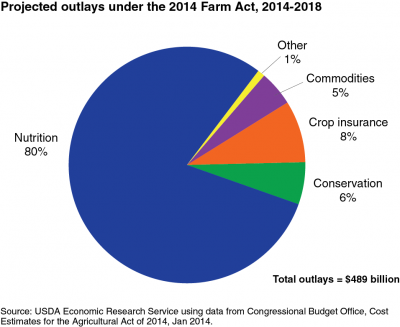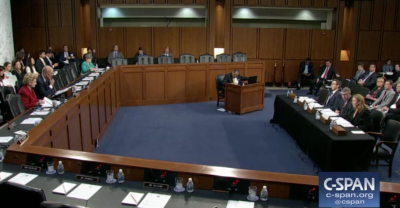Farm Progress' Joshua Baethge reported at the end of last week that "it’s hard to find anyone optimistic about passing a new farm bill this year. While the two political…
Senate Ag Committee Farm Bill Hearing: SNAP Quality Control Issues
On Thursday, the Senate Agriculture Committee held a Farm Bill hearing that focused on nutrition programs and the 2018 Farm Bill. This was the Committee’s eighth Farm Bill hearing, and followed field hearings in both Kansas and Michigan, as well as Committee meetings on the farm economy, agricultural research, conservation issues and commodity, credit, and crop insurance programs. The hearing focused on fraud in the SNAP program (food stamps), and specifically highlighted program payment error rates and misreporting of program costs by some states.

Bloomberg writer Alan Bjerga reported earlier this week that, “Senate Agriculture Chairman Pat Roberts signaled that he wants to use the next farm bill to target fraud in the food-stamp program, a move that could endanger the bipartisan support he needs to get the measure through Congress.
“‘There are significant quality control problems with the SNAP program,’ Roberts said in an emailed statement. ‘That’s a $70 billion program, so any problems will need to be given a hard look.'”
Mr. Bjerga explained that, “The Senate Agriculture Committee plans to hold a hearing Thursday focusing on misreporting of costs in the Supplemental Nutrition Assistance Program, which spent $66.5 billion on benefits in the 2016 fiscal year. A national payment-error rate of 3.2 percent, which includes both over- and under-payment of benefits, was last reported in 2014.
“Since then, the USDA Inspector General has found evidence of irregularities in state reporting. Advocates for tightening rules say states have an interest in lowballing error rates in an effort to get more federal funds for their states.”
In his opening statement at yesterday’s hearing, Ag Committee Chairman Pat Roberts (R., Kans.) noted that, “As we conduct this review, it is important to remember the purpose of these critical nutrition programs. They are not about long-term dependency; they are about giving aid in times of trouble. They are about ensuring our nation’s security, helping folks become productive members of our economy, and assisting the vulnerable among us who cannot help themselves.”
“Unfortunately, we have learned of some significant issues regarding the administration and oversight of the Supplemental Nutrition Assistance Program, or SNAP.”
Inflation-adjusted @USDA expenditures for food and nutrition assistance, fiscal 1985-2016, @USDA_ERS pic.twitter.com/srTCTnEWAo
— Farm Policy (@FarmPolicy) September 12, 2017
Chairman Roberts explained that, “Investigations by the Department of Agriculture Food and Nutrition Service, the Department’s Office of Inspector General, and the Department of Justice have revealed that states have purposely used ‘whatever means necessary’ to mislead the federal government to obtain bonuses or avoid financial penalties.”
Simply put, no one knows the error rate of SNAP, and that is unacceptable. And, the federal government does not even know the basic elements of the problem, such as how long this has been occurring.
Note that yesterday’s Morning Agriculture report from Politico indicated that, “Senate Ag staff are careful to note Roberts is not interested in making drastic cuts to the [SNAP] program, but instead wants to take a much closer look at how it is being administered, especially if taxpayer savings could be the result. ‘This is not about pushing people off the program; this is about how the program is run,’ a committee aide told [Morning Agriculture].

Committee Ranking Member, Debbie Stabenow (D., Mich.) pointed out in her opening statement yesterday that, “As the economy has improved and people are getting back to work, we’re seeing huge savings in nutrition programs.
“The Congressional Budget Office recently estimated that the Farm Bill is projected to save $80 billion more than initially expected, largely driven by reduced spending on food assistance.”

Brandon Lipps, the Acting Deputy Under Secretary for Food, Nutrition and Consumer Services and Administrator for the Food and Nutrition Service testified yesterday that, “As you know, SNAP operates a quality control, or ‘QC,’ system to measure improper payments, commonly referred to as the payment error rate. The SNAP payment error rate is a measure of the extent to which SNAP benefit amounts are issued in the proper amount to the targeted households. The error rate is the combination of payments to recipients that are too high (overpayments) as well as payments that are too low (underpayments), not the difference between the two.”
Mr. Lipps noted that, “Quality control is a shared responsibility between the States and FNS. States review cases for errors and FNS reviews a sample of those to ensure that States have made the correct determination. As you may know, USDA and the Office of Inspector General (OIG) both found bias in the QC data which impacted our ability to release a national error rate for FY 2015 and FY 2016.”

Mr. Lipps added that, “Many States were bypassing our data controls. In some cases, these were inadvertent process errors, but more often, States were altering what information and data they reported to FNS so Federal reviewers would not even see many of the errors. Therefore, we could not detect this level of bias until we developed the new statistical measures to catch it.
“During this same time, OIG had independently begun an audit of several states for similar problems. Based on the findings of the September 2016 OIG audit as well as the in-depth reviews conducted by FNS, we began an extensive process of working with States to implement corrective actions to dramatically reduce errors.”
Gil Harden, the Assistant Inspector General for Audit at the USDA’s Office of Inspector General told the Committee yesterday that, “The SNAP error rate is an important measurement used for two primary purposes. First, it is the basis for awarding State bonuses for high payment accuracy and assessing State penalties for poor performance. Second, it serves as the improper payment rate for SNAP.”
Mr. Harden explained that:
We found that confidence cannot be placed in FNS’ reported QC error rate. States weakened the QC process by using third-party consultants and error review committees to mitigate individual QC-identified errors rather than improving eligibility determinations. FNS’ QC process thus tended to understate SNAP’s error rate.
During the discussion portion of yesterday’s Senate Ag Committee hearing, Chairman Roberts noted that, “But what I have heard is extremely disturbing.
The integrity of the largest food assistance program, that spends over $70 billion a year, is simply unknown.
“The OIG has found that the quality control process is broken and in need of reform. And not only that, but we have a number of states that have defrauded the federal government and are being investigated by the Department of Justice.
“Mr. Lipps, you stated that the 2014 error rate data raised questions at FNS. Once the agency completed its in-depth review, did you discover any indication when bias entered states’ quality control process? Do you have a sense at what point the state error rates became inaccurate?”
Mr. Lipps indicated that, “Senator, unfortunately, I can’t give you an exact answer to that question. We do have concern that bias has been in the system for quite some time. The OIG notes in its report that this consultant first started acting with states as early as, I believe it was, 2004, when states’ individual error rates started dropping dramatically. So I think there’s been some level of bias in the system for over a decade.”
“So we have a problem here that could have started 13 years ago,” Chairman Roberts asked, and Mr. Lipps responded by saying, “That’s correct.”
Chairman Roberts also indicated that, “The FNS review, Mr. Lipps, for Fiscal Year 2015, found that 42 out of 53 states and territory agencies were improperly administering the quality control process. A document referenced by the media indicated that the very preliminary estimates of the 2015 national error rate could be between four and seven percent. Now if that’s the case, seven percent would be almost double the 2014 error rate. Something’s pretty fishy here. That was biased and would have indicated over $5 billion in error. Do you have any updated estimates for 2015?”
Mr. Lipps stated that, “Mr. Chairman, unfortunately we do not, but data is so significantly biased that we do not feel we can provide you an accurate measure of that rate.”
Chairman Roberts asked Ann M. Coffey, the Assistant Inspector General of Investigations at the USDA’s Office of Inspector General, “Have you ever encountered a case like this, where so many states have been defrauding the federal government?”
Ms. Coffey responded by saying, “Sir, I’ve been doing this job for a number of years and I can tell you this is a unique situation. We have not encountered this type of an investigation previously in my experience.”
Bloomberg writer Alan Bjerga reported yesterday that, “Errors by states in reporting improper food-stamp payments have thrown the program’s integrity into question, Senate Agriculture Committee Chairman Pat Roberts said, prompting Democrats to warn against using misreporting as an excuse to cut assistance.”
Mr. Bjerga noted that, “Senator Debbie Stabenow of Michigan, the panel’s top Democrat, said that even with the uncertainty about the figure, nutrition programs ‘have an extremely low rate of error and fraud.’ She drew a distinction between fraud committed by food-stamp recipients with misreporting by states. She urged committee members not to let reporting problems drive discussion of the program.
“‘As we look ahead, we will continue to fine-tune programs and protect food access for millions of people,’ she said.
“A new law reauthorizing nutrition programs and farm subsidies is due Sept. 30, 2018. Lipps said a new national error rate for SNAP would be available by mid-year in 2018, after reporting problems are fixed.”
And, Bartholomew D. Sullivan reported yesterday at USA Today Online that, “A second panel of witnesses at Thursday’s hearing included a SNAP recipient, a food bank operator, an Alabama independent grocer who offers shoppers free shuttle rides to his store, an academic who advocated raising benefits and the CEO of a prisoner reentry program. Each made a series of recommendations.
“Jimmy Wright, who operates the Wright’s Market in Opelika, Ala., and its ‘Wright to You’ shuttle service, said independent grocers would find ‘unworkable’ proposals to restrict candy and sugary drinks from SNAP eligibility, as some have proposed. He said SNAP is 40 percent of his retail sales.
“Northwestern University economics professor Diane Schanzenbach, who noted SNAP kept 8.4 million out of poverty in 2014, said it also acts as an effective stimulus during recessions, expanding as unemployment increases and shrinking as recovery begins. She said block-granting or capping its benefits, as some have proposed, would cripple that broad societal benefit of what she called a good public investment.”





